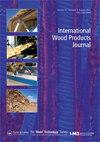Dynamic mechanical analysis of Scots pine and three tropical hardwoods
IF 0.9
Q2 MATERIALS SCIENCE, PAPER & WOOD
引用次数: 4
Abstract
ABSTRACT Dynamic mechanical analysis (DMA) was used to investigate the viscoelastic behaviour of four species of wood, Scots pine, Gmelina, Obeche and Alstonia. Three frequencies (0.1, 1.0 and 10 Hz) were used over a temperature range of −150°C to +150°C. All the wood species showed tan δ peaks corresponding with secondary relaxations in the expected range. The low temperature (γ peak) was seen at −115°C to −83°C, differing between species and with frequency. β peaks relating to hemicellulose relaxations in association with water molecules were observed, at two locations for Scots pine and three locations in hardwoods. The α peak for lignin lay outside the temperature range studied. Differences in β peaks are proposed to relate to the composition of hemicellulose, and be influenced by structure and level of heterogeneity in the amorphous polymer domains; differing between the wood species studied, which is in-line with currently proposed cell wall polymer models.苏格兰松和三种热带硬木的动态力学分析
摘要采用动态力学分析(DMA)方法研究了四种木材的粘弹性行为,这四种木材分别是苏格兰松、金缕梅、欧贝和阿尔斯通。三个频率(0.1、1.0和10 Hz)在−150°C至+150°C的温度范围内使用。所有木材物种都显示出与预期范围内的二次弛豫相对应的tanδ峰。低温(γ峰)出现在−115°C至−83°C,不同物种和频率不同。在苏格兰松的两个位置和硬木的三个位置观察到与水分子相关的半纤维素弛豫的β峰。木质素的α峰位于所研究的温度范围之外。β峰的差异被认为与半纤维素的组成有关,并受到无定形聚合物结构域中的结构和异质性水平的影响;所研究的木材种类不同,这与目前提出的细胞壁聚合物模型一致。
本文章由计算机程序翻译,如有差异,请以英文原文为准。
求助全文
约1分钟内获得全文
求助全文
来源期刊

International Wood Products Journal
MATERIALS SCIENCE, PAPER & WOOD-
CiteScore
2.40
自引率
0.00%
发文量
27
 求助内容:
求助内容: 应助结果提醒方式:
应助结果提醒方式:


